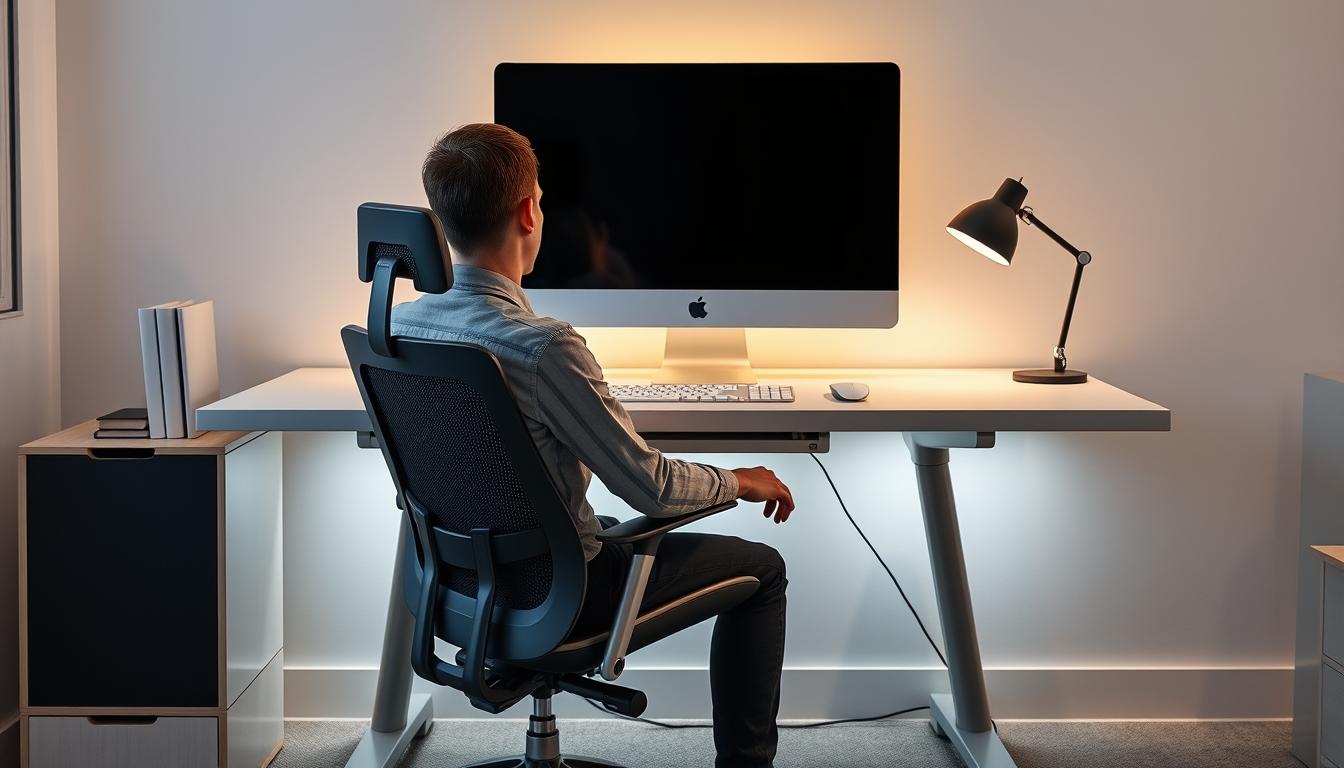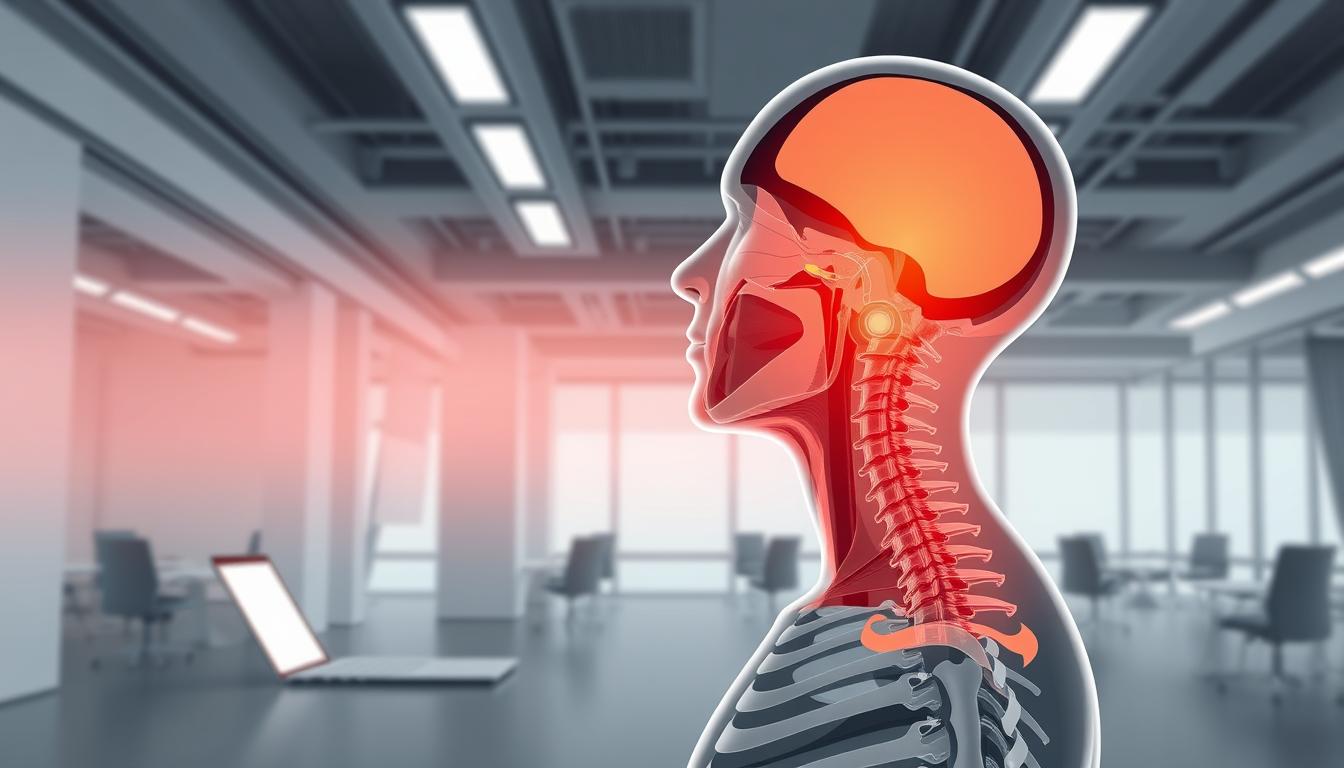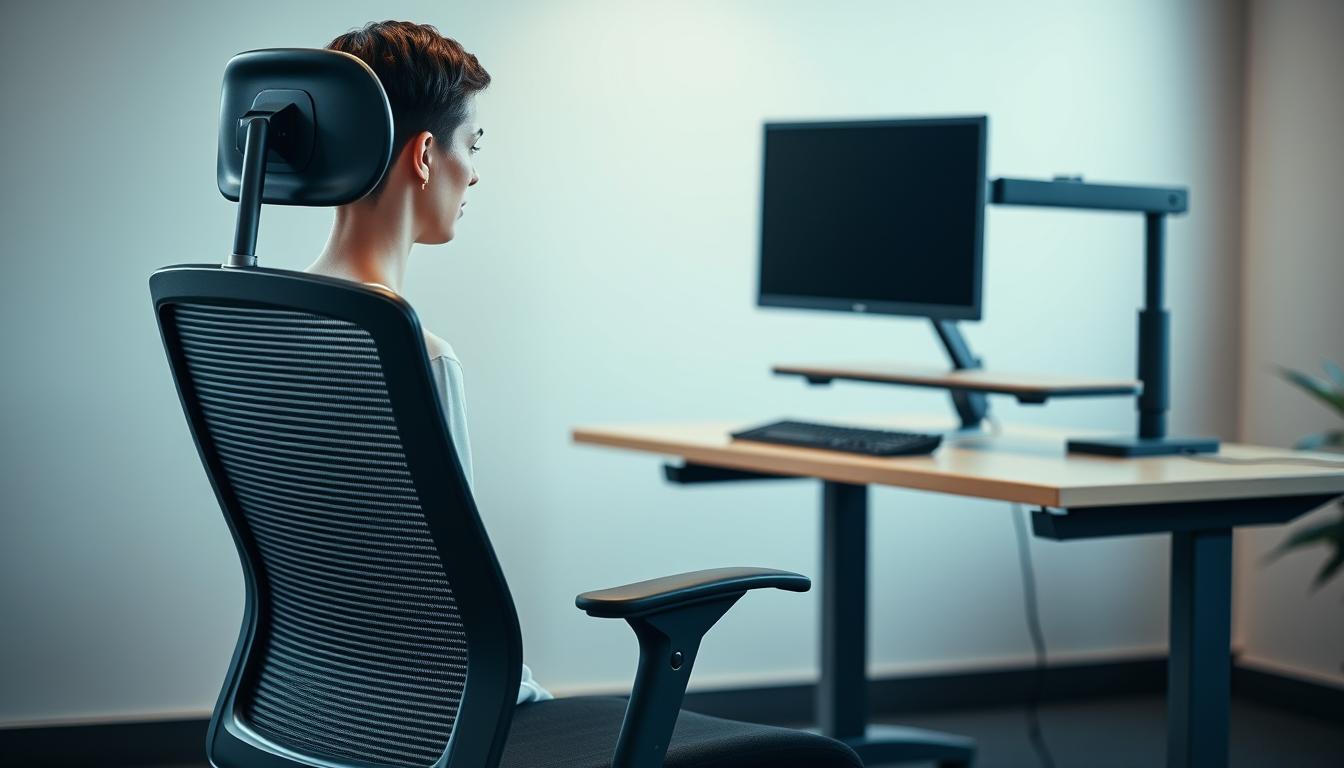Working from home is now more common than ever. It’s key to set up your desk the right way to stay comfy and productive. Good ergonomics can stop neck pain, back problems, and wrist pain.
When your workspace is set up well, you do better work and aren’t as likely to get hurt. Experts like those at the Mayo Clinic and OSHA say having the right setup isn’t just nice, it’s needed. Setting up a cozy spot for work helps you keep your focus and work well all day.
Understanding the Importance of Ergonomics in Remote Work
As more people work from home, knowing about ergonomics is key for staying healthy and productive. A bad workstation setup can cause discomfort. This not only makes us uncomfortable but also impacts our health. Ergonomics helps you set up your work area so it suits you best. By doing this, you avoid problems that come from sitting too long or bad posture.
Research from the Mayo Clinic shows that good ergonomics can lead to fewer health issues like neck and back pain. By applying ergonomic principles, you can improve your body alignment and blood flow. This brings big health benefits. Making small changes to your workstation can help you work longer without getting tired or sore.
Making ergonomics a priority in home offices is essential for a healthy life. By following these tips, you not only feel better but also work more effectively. This leads to being more productive and happy with your work.
Choosing the Right Chair for Maximum Support
Picking out an ergonomic chair is key for staying comfy and healthy during the work-from-home grind. Good ergonomic chairs with lumbar support, adjustable height, and proper armrests help prevent aches and boost work performance. Experts in ergonomics stress how important it is to have these features in any home office.
Characteristics of an Ergonomic Chair
Here’s what to look for in ergonomic chairs:
- Lumbar support: A chair that offers solid back support keeps your spine aligned right.
- Height adjustability: Being able to adjust the chair’s height makes sure your feet stay flat on the ground, which means more comfort.
- Armrest positioning: Adjustable armrests help keep your neck and shoulders from getting strained.
- Seat depth and width: The right size chair supports your body comfortably without any issues.
Adjusting Your Chair for Optimal Comfort
To make sure you’re as comfy as possible, here’s what to do:
- Keep your feet flat and your thighs level with the floor.
- Fix the chair height so your elbows form a neat 90-degree angle at the keyboard.
- Position the lumbar support right against your lower back for better back care.
- Set the armrests so your shoulders stay relaxed while you sit.
Creating an Ideal Desk Environment
Making your desk setup ideal is key to improving ergonomics and boosting productivity. How your desk is arranged, including its height, really matters for comfort and how well you work. By following tips on how to set up your space, you can feel more comfy and get more done.
Desk Height and Space Considerations
Having your desk at the right height keeps your elbows at a comfy 90-degree angle when you type. An adjustable desk is great because it lets you switch between sitting and standing. Make sure your desk has enough room under it for your legs to prevent any discomfort. Your desk should support a good sitting posture and have space for your computer and other essential gear.
Decluttering for Better Workflow
A tidy workspace can really help you focus and be more productive. A space without mess cuts down on distractions and makes it easier to concentrate on your work. Use things like drawers, shelves, and organizers to keep what you need close but out of sight. Check your desk setup often and get rid of stuff you don’t need to keep things running smoothly.
Neck-Friendly Desk Setup for Remote Workers
An ergonomic workstation is key for comfort during long work hours. A setup that’s easy on the neck is especially important for people who work from home. Positioning monitors correctly and using laptop stands are big steps towards this goal.
Positioning Your Monitor for Comfort
The right spot for your monitor can boost comfort. It should be at eye level, an arm’s length away. This helps cut down on neck strain, making it easier to keep your head in a natural position.
Make sure the top of your screen is at or just below eye level. This helps keep your neck relaxed and your posture good.
Using Laptop Stands to Avoid Strain
If you use a laptop, setting it up right is important. A laptop stand can raise the screen to the right height, just like a desktop monitor. This keeps you from slouching and protects your neck.
Adding an external keyboard and mouse can make it even better. This way, you can work more comfortably.
Keyboard and Mouse Placement for a Relaxed Posture
Proper placement of your keyboard and mouse is key to a comfy posture while working remotely. By setting up your desk the right way, you can ease the strain on your hands, wrists, and arms. It’s important to line them up with your body and choose ergonomic products.
Aligning Your Keyboard and Mouse with Your Body
To stay relaxed, make sure your keyboard and mouse line up with your elbows. This keeps your wrists straight and comfy as you type or navigate. Here’s how you can align them just right:
- Make sure your chair is at the right height so your arms are level with the floor.
- Hold your elbows close to your side, making a 90-degree bend.
- Position the keyboard so your wrists stay straight, not bent, while typing.
- Keep the mouse close to avoid reaching and straining your arm.
Choosing an Ergonomic Mouse to Reduce Strain
Picking an ergonomic mouse is key to better mouse ergonomics and less stress. The Logitech M720 is a good choice because it’s comfy to use for a long time. When choosing a mouse, look for one that:
- Matches the shape of your hand well.
- Has buttons that are easy to press without tiring your fingers.
- Offers adjustable sensitivity for easier control.
Try using keyboard shortcuts and switch hands for different tasks. These steps help you maintain a relaxed posture and avoid injury from doing the same thing too much. Following these advices will make working remotely more comfortable and efficient.
Frequent Breaks and Movement to Avoid Stiffness
Working from home means taking breaks often to prevent stiffness. Desk stretching can relieve muscle and joint tension, boosting productivity. Adding reminders to move around during your workday leads to healthier habits.
The Importance of Stretching During Work Hours
Stretching at your desk is key for your health at work. It boosts blood flow, fights muscle tightness, and helps you sit better. Quick stretches can fit into your day and focus on important areas like neck and back, easing pain.
Setting Timers for Regular Movement
Using timers for movement reminders helps create good work habits. Breaking every 30 minutes lessens discomfort. Try standing, walking, or simple exercises during these breaks. These actions disrupt long sitting periods and highlight the value of taking breaks for a healthier workspace.

Enhancing Lighting and Ambiance in Your Workspace
Choosing the right desk and chair isn’t enough to create an effective workspace. Good lighting is vital for productivity and comfort. It lessens eye strain and makes the ambiance pleasant, helping you stay focused all day.
Types of Lighting that Reduce Eye Strain
For focus and comfort, the right lighting is key. Here are some great lighting options for your workspace:
- Natural light: Position your desk near a window to take advantage of sunlight.
- LED lights: These provide exceptional brightness and energy efficiency while being easier on the eyes.
- Task lighting: Desk lamps with adjustable brightness help target specific areas and minimize glare.
Creating a Comfortable Temperature and Atmosphere
The climate in your workspace also affects your work. A comfortable temperature and a nice atmosphere boost focus and work quality. Consider these factors:
- Ventilation: Ensure adequate airflow to reduce stuffiness.
- Temperature regulation: Aim for a temperature around 68-72°F to keep both body and mind at ease.
- Personal touches: Incorporating plants, artwork, or photos can create a more inviting space.
Personalizing Your Workspace for Better Productivity
Making your workspace your own can really up your productivity game. It’s all about choosing things that speak to you and make you feel comfy and inspired. Getting the right gear for your desk helps you find your creative zone and stay focused on your work.
Adding Accessories for Comfort and Inspiration
Adding cool stuff to your desk makes it both useful and fun. Think about getting:
- Comfy cushions for your chair.
- Inspiring art or quotes to keep you going.
- Plants to clean the air and help you relax.
These touches make your desk space feel like it’s truly yours, keeping you motivated all day long.
Utilizing Feng Shui Principles to Boost Focus
Feng Shui can also help make your desk a place where focus and good vibes flow. The way you set up your desk and decorations can play a big part in your productivity. Here are some Feng Shui tips:
- Put your desk where you can see the door, but don’t sit right in front of it.
- Keep things tidy to avoid distractions.
- Choose colors that make you feel calm and creative.
Using these ideas, along with making your workspace your own, can really make a difference in how well you work and how happy you feel doing it.
Common Mistakes to Avoid in Ergonomic Setup
Working from home poses ergonomic setup challenges for many. Knowing common mistakes helps improve comfort and work output. It’s important for anyone wanting a better work environment to recognize these errors.
Replacing the Chair with Cushions Instead of Supportive Seating
One common mistake is swapping an ergonomic chair for cushions. Cushions might feel comfy at first but don’t offer needed support. A good ergonomic chair supports your back and helps prevent posture problems, making it crucial for daily use.
Ignoring Frequency of Breaks and Movement
Staying still for too long causes discomfort and makes posture worse. People often forget to take enough breaks, leading to stiffness and tiredness. Remembering to move regularly helps avoid these issues, boosting circulation and concentration all day.
Conclusion
Making your desk ergonomic is key to feeling good and working well from home. By picking the right chair, setting your desk at the right height, and using accessories wisely, you create a space that boosts your health. This is super important for staying in top shape while working remotely.
To set up your space well, adjust your chair and screen, place your keyboard and mouse correctly, and move around often. These small tweaks can make a big difference in your comfort and work performance. By following these tips, you’ll make your remote work spot both comfy and productive.
Don’t forget to check and tweak your workspace now and then to suit your needs. Adding what you learned from this article into your daily life shows how small changes can improve your focus and work efficiency. Putting ergonomics first makes working from home healthier and more fun.



